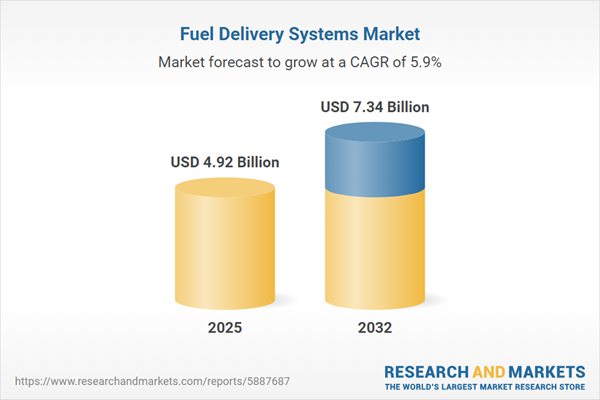Speak directly to the analyst to clarify any post sales queries you may have.
The global fuel delivery systems market is evolving rapidly, shaped by digital advancements, regulatory changes, and the emergence of new fuel types. Senior decision-makers must adopt agile strategies that deliver efficiency, resilience, and compliance amid shifting industry demands.
Market Snapshot: Fuel Delivery Systems Market Growth
Experiencing robust compound annual growth and supported by favorable forecasts, the fuel delivery systems market is maintaining a steady upward trajectory. Demand continues to rise for both established and alternative fuels, fueling investments across the entire supply chain. The integration of digital transformation—especially real-time analytics—enables companies to address compliance requirements more effectively, while optimizing global operations. As organizations leverage these technologies, they enhance their competitive edge and facilitate international expansion, setting new benchmarks in industry standards and catalyzing product innovation.
Scope & Segmentation of the Global Fuel Delivery Systems Market
This market research report provides senior leaders with actionable intelligence to navigate the ongoing shifts within the fuel delivery systems market. Each segment enables more focused targeting of growth opportunities and improved adaptation to evolving technology and regulatory pressures.
- Fuel Types: Biofuels such as biodiesel and ethanol align with decarbonization efforts and support evolving compliance strategies. Compressed natural gas (CNG) and liquefied petroleum gas (LPG) provide adaptable options for industrial and transportation sectors. Diesel and gasoline remain important in established transport applications, hydrogen offers promise for low-emission needs, and liquefied natural gas (LNG) serves a range of industrial processes.
- End Uses: Automotive and rail segments rely on dependable supply and efficient logistics. Aviation and maritime sectors place a priority on operational safety and adherence to strict standards. Industrial and power generation users require scalable, reliable solutions for continuous production across global footprints.
- Delivery Mechanisms: Distribution spans barges, pipelines, ships, road and rail tankers, as well as advanced drone-delivery. Integrating digital data into these channels enhances business agility and supply chain performance.
- Distribution Channels: Bulk supply addresses agriculture and industry needs. Direct service models cater to commercial and residential clients. Mobile and onsite refueling capabilities meet fleet requirements, while retail and franchise channels improve access across diverse business types.
- Regions: The Americas, Europe, Africa, the Middle East—including Gulf nations—and Asia-Pacific each present unique regulatory landscapes and levels of technology adoption. Success depends on adapting strategy to accommodate local conditions and market maturity.
- Key Companies: Leading organizations such as Robert Bosch GmbH, Denso Corporation, Continental AG, Delphi Technologies PLC, Hitachi Astemo Ltd., Aisin Seiki Co. Ltd., MAHLE GmbH, Stanadyne LLC, Keihin Corporation, and Magna International Inc. are broadening their offerings to address changing industry requirements.
Key Takeaways for Senior Decision-Makers
- Implementing integrated digital platforms and IoT analytics allows organizations to enhance supply chain visibility, supporting proactive management in fluid market environments.
- Upgrading legacy infrastructure to meet current regulatory standards prepares organizations for evolving regional and global requirements and supports stronger risk management.
- Depth of collaboration with technology partners and industry peers improves end-to-end resource tracking and drives efficiency gains across the broader supply ecosystem.
- Adopting advanced logistics solutions—including drone-based and centralized scheduling—promotes business continuity and enables swift responses to potential disruptions.
- Real-time monitoring combined with digital scheduling tools helps enhance customer experience, enabling differentiation within highly competitive markets.
Tariff Impact: Responding to 2025 U.S. Regulatory Shifts
With changing U.S. tariffs poised to affect component costs in 2025, industry leaders are focusing on strengthening supplier relations, prioritizing domestic sourcing, and realigning project timelines to address risk. These proactive measures support continuity throughout the supply chain despite regulatory uncertainty.
Methodology & Data Sources
The report draws upon stakeholder interviews, targeted surveys, and comprehensive analysis of regulatory filings and corporate data. By triangulating multiple sources, it ensures validated findings and actionable guidance for industry leadership.
Why This Report Matters for Industry Leaders
- Empowers organizations to craft effective growth strategies and informed market entry decisions amid ongoing technological and regulatory transformation.
- Segmented and regional insights support precision in resource allocation and help optimize technology investments aligned with specific market demands.
- Provides timely intelligence for navigating dynamic supply chain conditions and evolving compliance challenges with reduced operational risk.
Conclusion
Armed with the actionable insights from this market research, executive teams can confidently direct investments and operations, strengthening organizations' resilience and adaptability in the fast-evolving fuel delivery systems sector.
Additional Product Information:
- Purchase of this report includes 1 year online access with quarterly updates.
- This report can be updated on request. Please contact our Customer Experience team using the Ask a Question widget on our website.
Table of Contents
3. Executive Summary
4. Market Overview
7. Cumulative Impact of Artificial Intelligence 2025
Companies Mentioned
The companies profiled in this Fuel Delivery Systems market report include:- Robert Bosch GmbH
- Denso Corporation
- Continental AG
- Delphi Technologies PLC
- Hitachi Astemo, Ltd.
- Aisin Seiki Co., Ltd.
- MAHLE GmbH
- Stanadyne LLC
- Keihin Corporation
- Magna International Inc.
Table Information
| Report Attribute | Details |
|---|---|
| No. of Pages | 184 |
| Published | October 2025 |
| Forecast Period | 2025 - 2032 |
| Estimated Market Value ( USD | $ 4.92 Billion |
| Forecasted Market Value ( USD | $ 7.34 Billion |
| Compound Annual Growth Rate | 5.8% |
| Regions Covered | Global |
| No. of Companies Mentioned | 11 |









